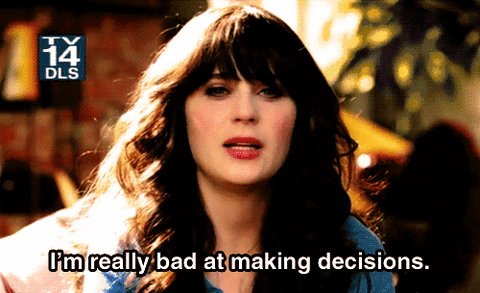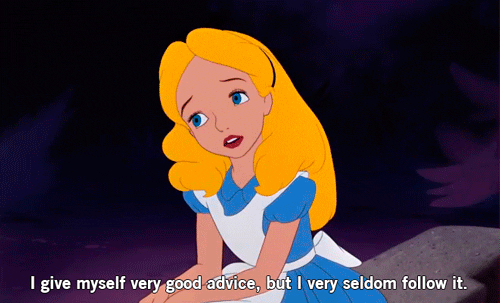Do you remember those “choose your own adventure” books from your childhood? Where the pages were filled with different options and the choices you made advanced the plot?
Yeah, real life feels a lot like that—except, it’s never-ending and not always as thrilling. That’s because we’re faced with a lot of decisions each and every day. And I mean a lot of them.
So instead of throwing your hands up in the air, what should you do instead in the face of an endless list of decisions?
Decisions, Decisions: Are We All Burnt Out On Making Choices?
Some estimates go as far as to say that you need to make upwards of 35,000 remotely conscious choices on a daily basis. Even funnier? A study out of Cornell found that you make over 200 decisions a day just related to what you’ll eat or drink.
It’s no wonder that so many of us feel like our decision-making muscles are worn out. In fact, the feeling of exhaustion over needing to choose between option A and option B is so relatable that it’s even been given a name: decision fatigue.
Plenty of research demonstrates that the quality of your decisions decreases as you make more choices, simply because you get plain ol’ tired of making them. And, it seems like nobody is immune. One study of judges (who we’d all like to think of as sound decision-makers) found that they were way more likely to grant parole in the morning, compared with later in the day.
Decisions can be exhausting, but they’re also an essential part of your daily life. From the small ones (what should you eat for lunch?) to the giant ones (should you change careers?), you’re in the driver’s seat.

So, how can you get better at making choices—particularly the big ones that have potentially major consequences? Should you engage in a rousing game of eenie, meenie, miney, moe? Throw a dart at a board?
As it turns out, a decision journal might just be the tool you need.
So…What Is A Decision Journal?
I can’t blame you if the term “decision journal” inspires visions of writing a bunch of heartfelt “dear diary” entries in a locked notebook.
But, this concept is actually a pretty straightforward journaling exercise. In your decision journal (it can be anything from a Google Document to a cheap notebook to even a Trello board), you simply chronicle your bigger decisions and record how you felt when you made them.
As an article for Farnam Street recommends, when you’re faced with a large decision, use your journal to document the following:
- The choice you’ve made
- What you expect to happen as a result of that choice
- Why you expect things to pan out that way
- How you feel about your decision
For example, imagine that you were wrestling with the choice of whether or not to apply for an internal transfer to a different department within your company. Once you’ve actually made your choice (you’re going to go for it and toss your hat into the ring!), you’d use your decision journal to jot down the nuts and bolts of that decision, your assumptions, and your emotional state when you settled on your outcome.
How A Decision Journal Can Help Declutter Your Brain
A decision journal isn’t necessarily an in-the-moment tool like a decision matrix or a trusty pros and cons list.
Instead, it’s something you’ll use for reflection. By documenting and periodically reviewing the decisions you make over time, you’ll get a better grasp on your state of mind and identify things like trends or common traps you find yourself falling into.
To put it simply, a decision journal helps to refine your decision-making process as you move forward, rather than being something that helps you actually make a choice in the moment.
If that seems like an unnecessary formality, I promise it’s not—because it’ll help you overcome something called the hindsight bias.
“Research shows that we selectively recall information that confirms what we know to be true and we try to create a narrative that makes sense out of the information we have,” explains an article for the Association for Psychological Science. “When this narrative is easy to generate, we interpret that to mean that the outcome must have been foreseeable.”
Basically, when you stroke your ego by telling yourself that you’re a fortune teller, you create major blindspots and lose out on opportunities to improve. You need to be able to clearly see where you make mistakes and why they happen. Ultimately, that information helps you make better choices moving forward.
Maybe your decision journal will illuminate the fact that you have the tendency to make irrational choices when you’re stressed and under the gun. Knowing this, you can move through future decisions by giving yourself some space to breathe and mull things over a little more.
Or, perhaps every time you marked down that you felt wary of a decision, it turned out poorly. That’s a sign that maybe you need to start trusting your gut.
How To Make The Most Of Your Decision Journal
The process of decision journaling itself is pretty cut and dried: you write down your decision, your assumptions, and your emotions.
But, there are a few other tips you’ll want to keep in mind to really make the most of this practice.
1. Don’t Use It For Everything
I know what you’re thinking: Journaling about your decisions is just another thing to add to your to-do list—which most of us don’t need, especially since 60% of workers reportedly feel stressed more than three work days per week.
Your decision journal shouldn’t be a burdensome activity that slows down the process of making every single decision.
Reserve it exclusively for the larger decisions that have potentially major consequences and require some serious thought and deliberation. After all, there’s no need to journal about whether you should order a turkey club or a chicken burrito for lunch that day.

2. Keep It Simple
Your decision journal should be used to evaluate your more complex decisions, but that doesn’t mean that the journal itself should be complicated.
Remember, you want this to be something that’s easy to refer back to and reflect on. Having pages and pages about every option you considered and every detail about your emotional state will only make this a cumbersome resource for you (meaning it’ll probably just collect dust in your desk drawer).
Use simple language, short sentences, and be as straightforward as possible when documenting your decisions and emotions. That will allow you to look back and get the information you really need—without wading through paragraphs of flowery language and unnecessary details.
3. Create A Simple Template For Yourself
One of the best ways to keep things simple is to create a template that you can use time and time again. It’ll prompt you to stay focused on the need-to-know information and remove a lot of the guesswork and ambiguity from the decision journaling process.
Whether you want to create a templated Trello card or start a simple document that you can keep copying, make sure that your decision journal template touches on the basics. Here’s what this could look like:
- Date I made this decision: ___________________________
- The decision I made was: ____________________________
- I believe this decision will lead to: __________________
- Why I believe this decision will pan out this way: _____________________________________________________
- How I feel about the decision I’ve made: ______________________________________________________
See? Not so difficult after all. Of course, you’re welcome to add more to your own template if it helps you, but the point is to at least get a basic process in place. That’ll make the process of journaling less daunting—and make you way more likely to stick to it.
4. Review Your Journal Frequently
A decision journal isn’t about helping you make choices in the heat of the moment. It’s a record that you can refer back to in order to understand your blind spots and make better decisions moving forward.
So, that means you need to actually look back at it—and you should plan to do so frequently (aim for every quarter, at the very least).
Research shows that we all tend to have an inflated view of our own performance. In one study, engineers were asked if they believed they were in the top 5% of the engineers at their company, and a whopping 40% of them said “yes.”
And, even further, our own self-ratings aren’t correlated with positive performance. A separate study of physicians found that things like supervisor and peer ratings of surgical residents were fairly accurate in predicting whether or not residents would perform well on their board exams, but there was zero relationship between self-ratings and their exam success.
“We apply a lot of positive spin to evidence we get about ourselves,” explains David Dunning, a Professor of Psychology at Cornell University, in an interview with NPR about both studies. “People obviously want to think pleasant things about themselves. They want to avoid thinking threatening things about themselves.”
In short, we aren’t great at honestly evaluating ourselves, which means we probably won’t be able to spot our decision-making weaknesses and pitfalls on our own.

If you answer honestly and follow your prompts, your decision journal will serve as an unbiased third party that will equip you with valuable feedback—provided you make the time to lean on it frequently, of course.
When it’s time for you to review your entries, give yourself some quiet, focused time to reflect:
- Are there mistakes you see yourself making again and again?
- Are there certain types of decisions that make you feel more anxious than others?
- What about the types of decisions that inspire a lot of confidence?
This time for self-reflection is more than just a feel-good exercise, as you’ll quickly identify areas of improvement. And, the more you do that, the better you’ll get at making choices—which will help you kick that pesky decision fatigue we mentioned earlier to the curb.
Flex Those Decision-Making Muscles And Put Pen To Paper
The “choose your own adventure” books of your childhood were fun. But, in real life, needing to make decision after decision can be draining and ultimately lead to some lackluster choices.
That’s why a decision journal should be your not-so-secret weapon. It’ll give you some helpful insight into your own decision-making process, so you can improve your selections moving forward.
While it’s not designed to help you pick between that turkey sandwich or burrito, it will help you approach your larger, real-life decisions with as much certainty as you had when you were a kid choosing which page to flip to.







































